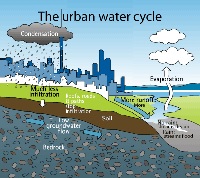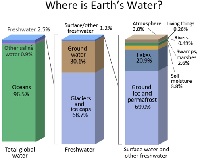|
|

|
|
Human Influences on Groundwater Availability
Prior to a recent knowledge about groundwater resources, it was commonly thought that groundwater was so isolated from the land surface that it was unaffected by human activities. As a more complete scientific understanding of groundwater developed, it became clear that large-scale agricultural practices and expanded urban centers created groundwater issues. Learn more in this introductory reading lesson!
(Hydrological Cycle - 6)
|
|

|
|
Groundwater Use & Availability
How much fresh groundwater is available for use by society? How does this availability vary across the globe or at different times? What controls the availability/variability? Develop your own answers to these questions through this reading lesson! A few short questions are included to stimulate critical thinking.
(Hydrological Cycle - 6)
|
|
|
|